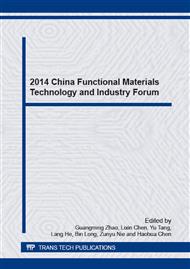p.697
p.702
p.707
p.711
p.719
p.724
p.731
p.737
p.750
Factors Affecting Optical Anisotropy Performance of Liquid Crystal Polymer with Photosensitive Group
Abstract:
A copolymer liquid crystal with a coumarin side group is synthesized and investigated. Under different exposure energy, the thin film of copolymer is irradiated by linearly polarized ultraviolet light (LPUV). Moreover, through changing exposure temperature and annealing temperature to investigate its photoreaction properties and reorientation performance. It is made clear that the value of optical anisotropy appears maximum with the increase of exposure energy. However, with the exposure temperature increasing, the Photo-Fries rearrangement tend to be occurred and the degree of the cyclo-addition reaction is reduced. Finally, dealing the exposed film with the liquid crystal temperature, the optical anisotropy of the film has cyclical change, but the maximum anisotropy remains nearly unchanged.
Info:
Periodical:
Pages:
719-723
Citation:
Online since:
December 2014
Authors:
Price:
Сopyright:
© 2015 Trans Tech Publications Ltd. All Rights Reserved
Share:
Citation:


